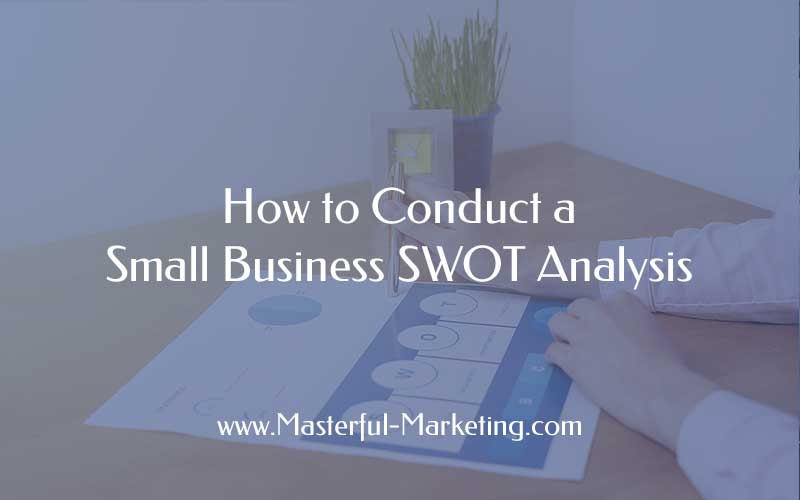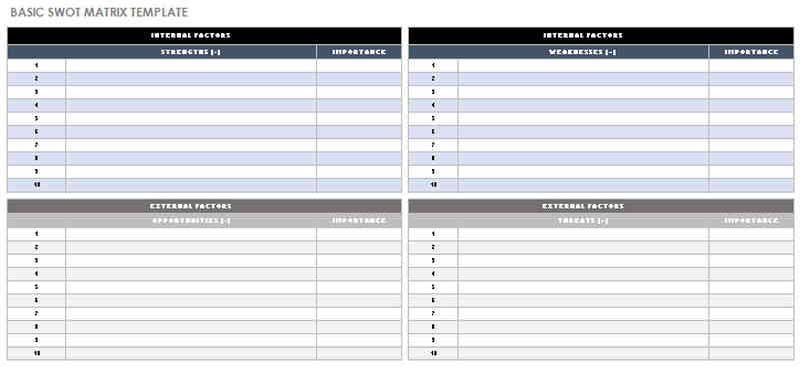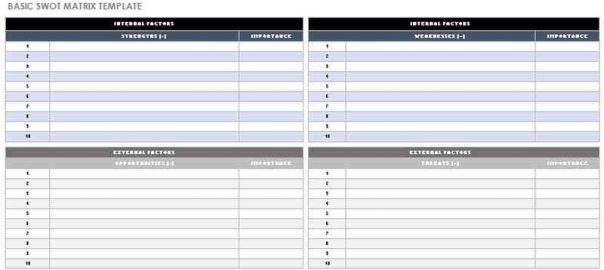
Small business owners tend to view their businesses very tactically. Taking an objective view of your business from both an internal and external perspective can uncover a host of opportunities while highlighting potential threats. A SWOT analysis can help you evaluate your small business and the surrounding business environment that can affect its overall success.
If you have not done a SWOT analysis for your business, it may be a good time to go through this exercise. Reviewing your business using a SWOT analysis is important to do prior to conducting your regular marketing review. The results can help you determine if you need to move marketing resources to take advantage of a new opportunity that align with your strengths. It can also help you decide to stop doing things that aren’t performing as expected.
What is a SWOT analysis?
A SWOT analysis helps you analyze your business from multiple perspectives. First you look inward at your business and identify your strengths and uncover your weaknesses. Then you analyze the external business environment to look for growth opportunities and external threats to your success.
When you conduct your SWOT analysis, you can then develop a marketing strategy that is consistent with the resources and capabilities of your company.
Why do a SWOT analysis?
A SWOT analysis forces you to examine your company from many different perspectives. The data you gather can help you:
- Determine whether you should enter or exit a particular market
- Fully capitalize on your strengths and address or eliminate weaknesses
- Find opportunities that you didn’t realize were available to you
- Proactively react to threats rather than letting them just happen
SWOT analysis process
The first step is to gather data about your business in the four areas of the analysis. Your template can be a simple spreadsheet or chart. The key is to document everything you find in the appropriate quadrant. If you have employees, let them participate as well. They may see things you do not. Here is great resource for templates you can download in either Excel or Smartsheet. Plus there are many other templates for Word or PowerPoint.

If you are an independent, look at your reviews, testimonials and other feedback from clients. Be realistic but don’t beat up on yourself when you get to weaknesses. We all have them!
Identify your strengths
Before you can find new opportunities, you need to understand what is going on in your business. Strengths are the positive, internal characteristics of your business with respect to your competition. Some questions you can ask:
- What are you good at?
- Do you have advantages over your competition that are hard to replicate?
- What do your customers say about you?
- How strong are your resources?
- Do you have a strong, highly visible brand?
- How strong is your financial position?
Don’t underestimate any quality when determining your strengths. What may seem insignificant to you just may be one of your more interesting qualities that will attract new clients and differentiate your business from the competition.
Examples:
- Unique / high quality products / services
- Solid cash flow
- Great customer service
- Highly skilled staff
- Established brand / good reputation
- Effective systems and processes that get things done quickly
Uncover your weaknesses
Weaknesses are internal factors that detract from your ability to maintain a competitive advantage. Although it is good to be brutally honest, it is not necessary to attack the business. Understanding your weaknesses can help you correct them or market around them.
By identifying your weaknesses, you have the potential of converting them into strengths. Some questions you can ask are:
- What are we not good at?
- Are we missing skills or resources to remain competitive? Are we dependent on one resource for our success?
- Have our customers or clients said anything that could help us improve?
- Is our location or online visibility not a strong as it should be?
- How do our customers perceive our brand?
- Do we have the limited capital?
- Are you trying to take on too much risk that can negatively affect your revenues?
These factors are under your control and you can choose to correct them if you feel it will help you remain competitive.
Look for new opportunities
Now to review the external environment.
Opportunities are external factors that fit within your business model and represent areas of potential growth.
What factors exist in the environment or market that if approached properly can increase sales, market share, or net profit? These areas are key to your marketing activities because investing a bit of effort into these areas can result in sizable areas of growth.
For most small businesses, opportunities may look like these:
- Are there potential partnerships that can open new markets for your company?
- Can you retool your product or service to serve an untapped market?
- If you focus more on one particular aspect of your business, are you able to reach more market share?
- Can you adjust how you sell your product or service to reduce expenses?
- Is our messaging reaching our target audience or would reworking them resonate better with our customers?
- Are there new tools and resources that can help us create better systems, reducing the time it takes to get things done?
Identify potential threats
Threats are external factors beyond your control that could place your marketing strategy, or the business itself, at risk. Identifying threats allows you to put contingency plans in place to address these factors if they should occur before they can affect your business negatively. These challenges are unfavorable economic trends that could lead to reduced revenues or profits.
Competition, whether existing or potential, is always a threat. Your existing competitors can make moves that can undermine your business. New competition can arise from a market shift or a new way of providing the same product to the end customer.
- Are there any potential competitors entering the market?
- Is government imposing any new regulations that can negatively impact our business?
- Are there changes in customer behavior that will reduce sales?
- Is there new technology that reduces the demand for our current products or services.
- Are there any economic changes that may prevent your customers from continuing to do business with you?
Make sure you address your worst fears during this part of the exercise. Better to be prepared than being blindsided later.
Information is good to have, but now take action
Once you have your SWOT analysis information, you can then use this to form a strategy to exploit the opportunities and deal with the threats. The strategy should align with your goals and current business model. But if there is an opportunity that could be extremely profitable, you may want to make the shift to accommodate it.
Look for ways to capitalize on your opportunities that play to your strengths. Given your resources, determine what you can give up to take on new challenges. Assess your weaknesses and determine which ones you can address now and which will take time to correct.
Keep in mind that as most businesses grow and evolve, their SWOT analysis changes. Review your analysis at least annually to ensure you aren’t missing any opportunities and are aware of the environment around you. This information enables you to create a better, more focused marketing plan.
Your SWOT analysis for your business should be short, simple and realistic about your strengths and weaknesses. Take some time to do this analysis. It can provide you with new insights about your business that will help you guide your company into new, profitable markets or avoid high risk situations.
Business & Finance Articles on Business 2 Community
(87)








